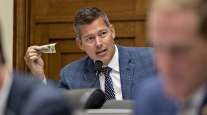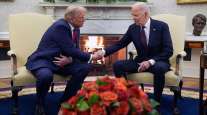Staff Reporter
Transportation Officials to Weigh Equity, Accessibility in Funding

[Stay on top of transportation news: Get TTNews in your inbox.]
Before awarding federal funds, U.S. transportation officials will look for projects offering greater access to people, especially in disadvantaged communities.
Echoing President Joe Biden’s theme of promoting equity, Transportation Secretary Pete Buttigieg and his leadership team revealed in a webinar May 25 how the U.S. Department of Transportation is shifting its views and delivery of programs.
“There has always been a connection between America’s search for racial and economic justice and the way that people and goods move around this country,” Buttigieg said to 1,400 participants attending DOT’s Info Session on Transportation Equity.
DOT along with 90 federal agencies released equity action plans April 14, the same day that the White House issued a statement recognizing the plans as important to address systemic barriers in federal programs and policies impeding progress for underserved communities. The plans were a furtherance of Biden’s Executive Order 13985: Advancing Racial Equity and Support for Underserved Communities Through the Federal Government. Signed Jan. 20, 2021, the order called on the federal government to allocate its resources to advance fairness and opportunity.
Today, my Administration released the first-ever Equity Action Plans.
Laying out more than 300 concrete commitments to tear down systemic barriers that have been allowed to fester for far too long. https://t.co/B7S9H5w0Ui — President Biden (@POTUS) April 14, 2022
Buttigieg said DOT and the administration are committed to building a better transportation system for everyone in the nation, while referencing Biden’s $1.2 trillion bipartisan infrastructure law.
“We have to be very intentional about this in our moment of construction, building and renewal because a piece of physical infrastructure lasts for decades and anything good or anything harmful that it could do will be with us for a very long time,” Buttigieg remarked.
He called DOT’s equity action plan a major milestone forming a foundation “for how we are viewing and delivering transportation programs,” including historical generational investments made through the BIL.
Irene Marion, DOT civil rights director and moderator the discussion, said the plan focuses on four equity areas: wealth creation, power of community, interventions and expanding access. Other panelists included Stephanie Pollack, deputy administrator of the Federal Highway Administration; Polly Trottenberg, transportation deputy secretary; Nuria Fernandez, administrator of the Federal Transit Administration; Shelby Scales, director of the Office of Small and Disadvantaged Business Utilization and Christopher Coes, principal deputy assistant secretary for transportation policy.
“There is a disconnect between the opportunities that everyone seeks and deserves and the way our transportation connects people to opportunity,” Pollack noted.
FHWA is now including in its criteria for awarding discretionary grants how much a project will provide transportation access for people.
“Whether for bridges or safe streets and roads, or reconnecting communities, we are asking our applicants to talk about how the grant they are seeking will expand access to opportunity, and we’ll be giving that lots of weight as we award those discretionary grants,” Pollack said.

Pollack
Because rural and tribal communities often lack staff and technical expertise to apply for complicated federal transportation grants, DOT is making special efforts to promote equitable access.
Coes said DOT will soon launch a “thriving communities” initiative to provide communities with direct and coordinated technical assistance across all stages of a project’s life cycle to ensure they can access federal funds and deliver infrastructure projects.
Other DOT initiatives in coming months will be an online technical assistance hub, a new grant application, program toolkits and a rural and tribal technical assistance pilot project.
“Each of these services and programs will provide experts on project finance, community engagement as well as support from a network of technical assistance providers across the country that will be on the ready to support disadvantaged and underserved communities,” Coes noted.

Coes
As an example of tailored assistance, he pointed to DOT’s website and online toolkit in its Rural Opportunities to Use Transportation for Economic Success (ROUTES) initiative as “our one-stop shop for rural communities who are looking for a department-level [web] navigator to support technical assistance.”
Pollack said FHWA is committed to helping applicants succeed in getting grants and helping deliver projects with assistance from state highway division offices and other local technical assistance programs.
Trottenberg noted that DOT aims to offer programs particularly for low-income and disadvantaged communities “that have not benefited from these federal dollars” to help them compete and win funds as well as build and operate successful projects.




